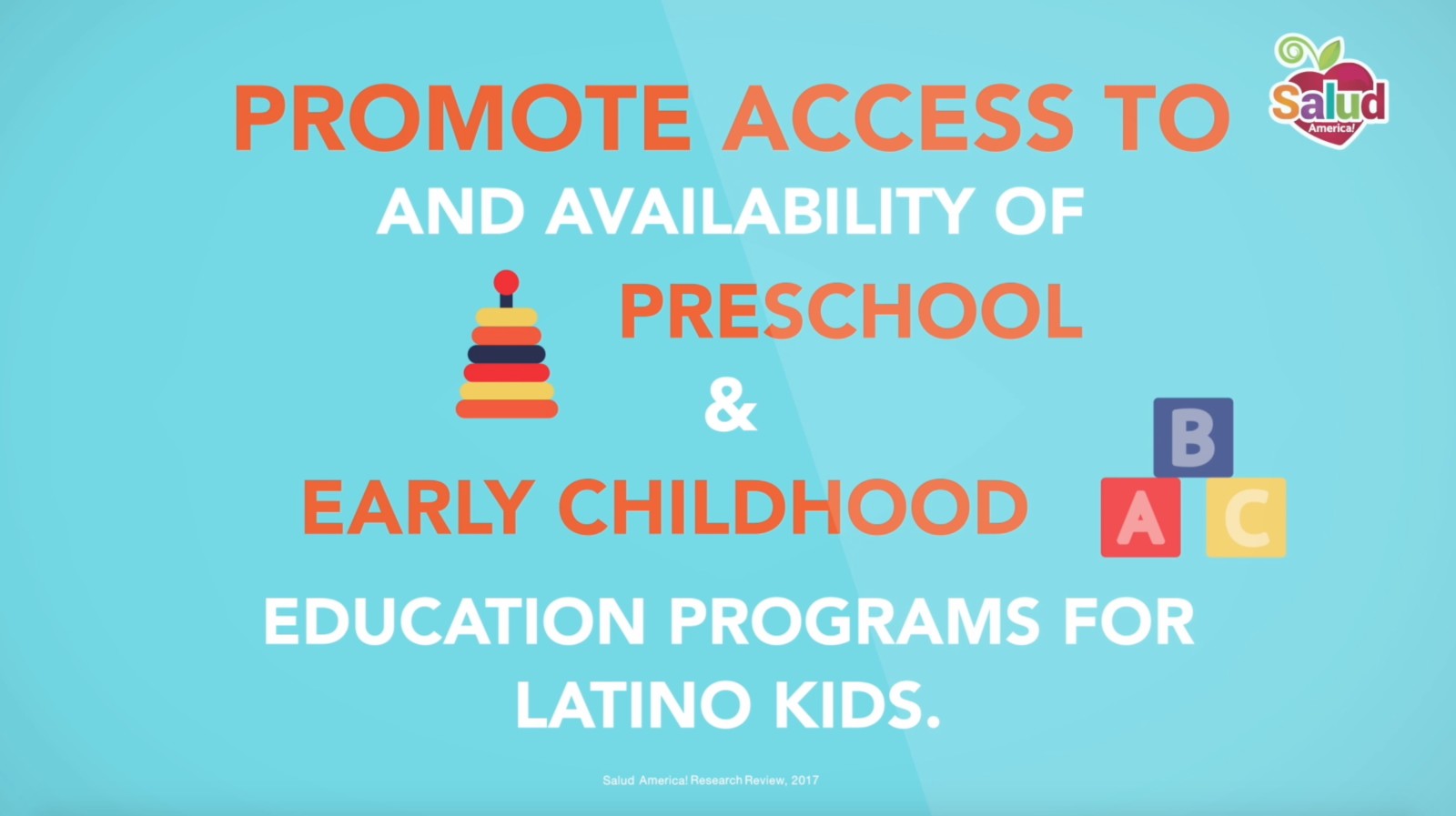
Share On Social!
This is part of the Salud America! The State of Latino Early Childhood Development: A Research Review »
The Benefits of ECE Programs for Kids
Children who participate in high-quality early care and education (ECE) programs experience a range of immediate and long-term cognitive and health benefits, with the greatest impact seen in low-income populations.98
 Although extensive literature is available on the long-term effects of Head Start and other early childhood development programs on black and white children, the effects of these programs on Latino populations have mostly been ignored.125
Although extensive literature is available on the long-term effects of Head Start and other early childhood development programs on black and white children, the effects of these programs on Latino populations have mostly been ignored.125
Additionally, nearly 40 years ago, it was recognized that cultural differences exist among the different Spanish-speaking people and that different subgroups should be analyzed separately. However, early data from Head Start centers tended to combine all Latinos into one group.125,126
Spanish-Language Preschools
From the available data, providing Spanish language in preschools was shown to enhance Latino and non-Latino education as far back as the 1980s, and current recommendations believe that Spanish language and culture should be instituted in preschool programs serving Latino communities.126–128
The Head Start Curriculum is mandated to have at least one Spanish-speaking educator, and that educator should be able to understand a Latino child’s culture and heritage.125
Long-Term Effects of Head Start
Although long-term effects of the Head Start program were not documented for individual children or for Latinos specifically, an overall cost-benefit impact was found in social, emotional and health outcomes.129–132
White children who attended Head Start were more likely to complete high school and attend college than their siblings who attended regular preschools. For black children, there were less significant educational gains from attending Head Start versus a regular preschool, but a decrease in criminal activity was observed.133
Different Programs with Different (Positive) Effects
The long-term effects of other preschool and elementary programs on low-income, but not necessarily Latino, populations are mentioned herein to sort out factors that led to successful outcomes in children attending these programs.
The Child-Parent Center program in Chicago provides educational enrichment through school- and family-based services from preschool to third grade. In this program, parent involvement was mandatory, teachers interacted with parents directly, and classroom sizes were small, all of which contributed to its success.134 Compared with children who did not participate in the program, those who participated in the preschool phase of the program were more likely to graduate high school, attend a 4-year university, and have more overall years of education. Those participating in the preschool and grade school phases had higher rates of full-time employment and educational attainment. Other long-term benefits of the program included increases in attainment of health insurance, reductions in depression and disability, and reductions in criminal activity and arrests.
The High/Scope Perry Preschool Program was implemented for 123 low-income black children who were followed up from preschool to age 40. Those participating in the program showed less criminal activity, greater earnings, higher rates of high school graduation, and higher IQs compared with those who did not.135 The Project STAR program enrolled children between kindergarten and third grade and showed that improved test scores, and higher earnings, college attendance, home ownership, and 401(k) savings at age 27, were due to noncognitive skills learned in high-quality kindergartens. They also showed that smaller and better classroom environments for grades 5-8 resulted in marked long-term benefits even without earlier intervention and that students from smaller classes (13-17 children vs 20-25 children) were more likely to attend college.136
Finally, the Abecedarian Project cared for and educated children from as young as 6 weeks to 8 years. Enrollment in the program led to better educational gains, mixed economic benefits, and no difference in social-emotional measurements compared with not being enrolled in the program.137
Taken together, the most successful elements in these studies—smaller class sizes, more parent involvement, and better-educated teachers—would likely benefit Latino children as well, if implemented in Latino-focused programs.
Importantly, these programs were more expensive to run than the Head Start programs.
More from our The State of Latino Early Childhood Development: A Research Review »
- Introduction & Methods
- Key Research Finding: Latino Childhood Trauma
- Key Research Finding: Healthy Lifestyles
- Key Research Finding: Early Care and Education
- Key Research Finding: Strategy—Improve Early Care
- Key Research Finding: Strategy—Boost School Readiness
- Key Research Finding: Strategy—Reduce Childhood Trauma
- Key Research Finding: Strategy—Incorporate Family Values
- Key Research Finding: Strategy—Support Moms
- Policy Implications
- Future Research Needs
References for this section »
98. Ramirez, A. Building Support for Latino Families: A Research Review. Salud America! (2017). Available at: https://salud-america.org/building-support-for-latino-families-research/. (Accessed: 25th October 2017)
125. Currie, J. & Thomas, D. Does Head Start Help Hispanic Children? Labor and Population Program, Working Paper Series 96-17. (1996).
126. Bean, F. D. & Tienda, M. Hispanic population of the United States. (Russell Sage Foundation, 1987).
127. Johnson, D. C., Lynch, S. & Stephens, C. Educational language policy and the new Latino diaspora in Iowa. (2016).
128. Puente, S. & Hernandez, R. Transforming Early Learning: Educational Equity for Young Latinos. (2009).
129. Currie, J. Economic Impact of Head Start. (2005). Available at: https://www.princeton.edu/~jcurrie/publications/CurrieANGxp.pdf. (Accessed: 17th August 2017)
130. Deming, D. Early Childhood Intervention and Life-Cycle Skill Development: Evidence from Head Start. Am. Econ. J. Appl. Econ. 1, 111–134 (2009).
131. Ludwig, J. & Phillips, D. A. The Benefits and Costs of Head Start. (National Bureau of Economic Research, 2007). doi:10.3386/w12973
132. Ludwig, J. & Phillips, D. A. Long-Term Effects of Head Start on Low-Income Children. Ann. N. Y. Acad. Sci. 1136, 257–268 (2008).
133. Garces, E., Duncan, T. & Currie, J. Longer Term Effects of Head Start. (2000). Available at: http://www.nber.org/papers/w8054.pdf. (Accessed: 17th August 2017)
134. Temple, J. A. & Reynolds, A. J. Benefits and costs of investments in preschool education: Evidence from the Child–Parent Centers and related programs. Econ. Educ. Rev. 26, 126–144 (2007).
135. Schweinhart, L. J. Long-term follow-up of a preschool experiment. J. Exp. Criminol. 9, 389–409 (2013).
136. Chetty, R., Friedman, J. N. & Rockoff, J. E. The Long-Term Impacts of Teachers: Teacher Value-Added and Student Outcomes in Adulthood. (National Bureau of Economic Research, 2011). doi:10.3386/w17699
137. Campbell, F. A. et al. Adult outcomes as a function of an early childhood educational program: An Abecedarian Project follow-up. Dev. Psychol. 48, 1033–1043 (2012).
By The Numbers
84
percent
of Latino parents support public funding for afterschool programs



